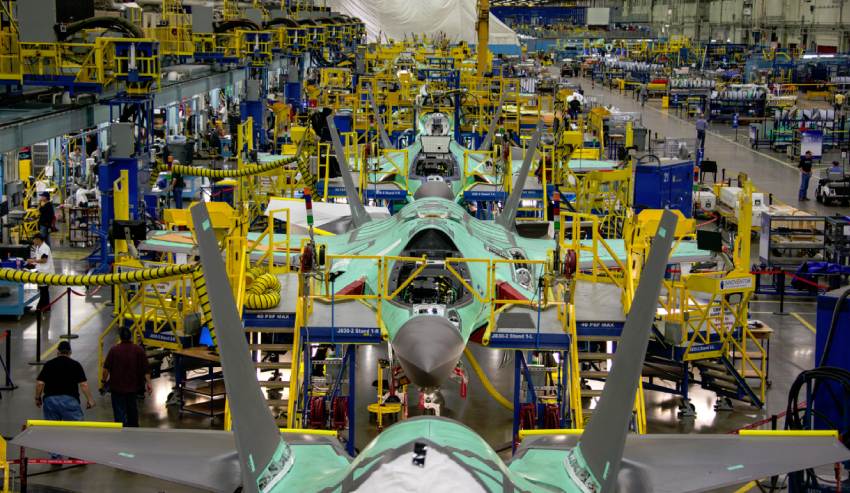Lockheed Martin successfully delivered 134 F-35 Joint Strike Fighter aircraft for the 2019 year, exceeding the joint government and industry 2019 delivery goal of 131 aircraft.
To continue reading the rest of this article, please log in.
Create free account to get unlimited news articles and more!
One hundred and thirty-four deliveries represent a 47 per cent increase from 2018 and nearly a 200 per cent production increase from 2016. Next year, Lockheed Martin plans to deliver 141 F-35s and is prepared to increase production volume year-over-year to hit peak production in 2023.
Greg Ulmer, Lockheed Martin vice president and general manager of the F-35 program, welcomed the milestone achievement, saying, "This achievement is a testament to the readiness of the full F-35 enterprise to ramp to full-rate production and we continue to focus on improving on-time deliveries across the entire weapons system."
The 134th aircraft is a short take-off and vertical landing (STOVL) model for the US Marine Corps. In 2019, deliveries included 81 F-35s for the US, 30 for international partner nations and 23 for foreign military sales customers.
"We have met our annual delivery targets three years in a row and continue to increase production rates, improve efficiencies and reduce costs. The F-35 is the most capable fighter jet in the world, and we're now delivering the fifth-generation weapon system at a cost equal to or lower than a less capable fourth-generation legacy aircraft," Ulmer added.
Using lessons learned, process efficiencies, production automation, facility and tooling upgrades, supply chain initiatives and more – the F-35 enterprise continues to significantly improve efficiency and reduce costs.
The price of an F-35A is now US$77.9 million, meeting the US$80 million price goal a year earlier than planned.
The F-35's mission readiness and sustainment costs continue to improve with the global fleet averaging greater than 65 per cent mission capable rates, and operational squadrons consistently performing near 75 per cent.
Lockheed Martin's sustainment cost per aircraft per year has also decreased four consecutive years, and more than 35 per cent since 2015.
Currently there are more than 490 aircraft operating from 21 bases around the globe, the F-35 plays a critical role in today's global security environment.
Today, 975 pilots and 8,585 maintainers are trained, and the F-35 fleet has surpassed more than 240,000 cumulative flight hours.
Eight nations have F-35s operating from a base on their home soil, eight services have declared Initial Operating Capability and four services have employed F-35s in combat operations.
In addition to strengthening global security and partnerships, the F-35 provides economic stability to the US and international partners by creating jobs, commerce and security, and contributing to the global trade balance.
Thousands of men and women in the US and around the world build the F-35. With more than 1,400 suppliers in 47 states and Puerto Rico, the F-35 program supports more than 220,000 jobs.
The Lockheed Martin F-35 Joint Strike Fighter is billed as a catalyst for the fifth-generation revolution, changing the face and capability of the Royal Australian Air Force and the wider Australian Defence Force.
For the RAAF, the F-35A's combination of full-spectrum low-observable stealth coatings and materials, advanced radar-dispersing shaping, network-centric sensor and communications suites – combined with a lethal strike capability – means the aircraft will be the ultimate force multiplying, air-combat platform.
The F-35A – the variant chosen by the RAAF – will have with a projected life of 30 years in service.
Ten nations are currently flying F-35s, including the US, UK, Italy, Norway, Israel and Japan. The first of Australia’s F-35A aircraft are now based on home soil after a period of training and development at Luke Air Force Base in Arizona, plus an epic Pacific Ocean crossing in December 2018.
More than 340 F-35s are operating today with partner nations, more than 700 pilots and 6,500 maintainers have been trained, and the F-35 fleet has surpassed more than 170,000 cumulative flight hours.
Over the coming years, Australia will purchase 72 of the advanced fifth-generation fighter aircraft as part of the $17 billion AIR 6000 Phase 2A/B program – which is aimed at replacing the ageing F/A-18A/B Classic Hornets that have been in service with the RAAF since 1985.
Stephen Kuper
Steve has an extensive career across government, defence industry and advocacy, having previously worked for cabinet ministers at both Federal and State levels.

 Login
Login








